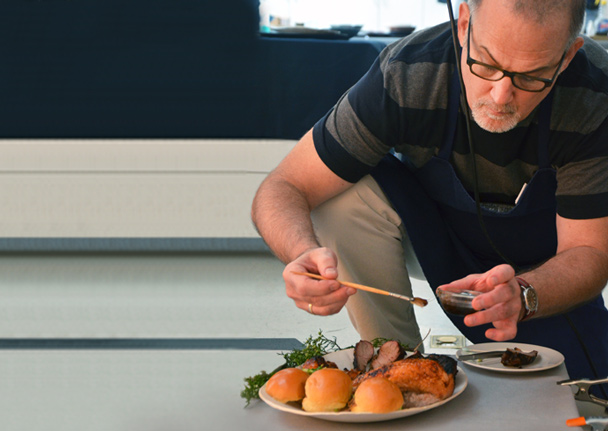In this era in America's cultural history, when the pursuit of math, science, and technology overshadows the arts, it's crucial to learn from individuals who bucked convention, followed their artistic bliss, and found a way to use their craft professionally. In the process, many of these talented people have affected our everyday lives in powerful ways you might never guess.
A prime example is Paul Grimes. Back in the '70s, he was a studio art major—that's right, the major that draws rolling eyeballs from parents and such types, along with the dreaded question, "How do you plan to support yourself with that?" Grimes listened to his heart, pursued his studies, and ended up in the food business, long before it was trendy. Today, he uses his artistic training to help make the sort of stunning photographs that inspire us all to get in the kitchen and cook, stat.
If you're a food magazine junkie, you've seen gorgeous images of dishes Grimes cooked and styled for the camera in Gourmet magazine, where our careers first overlapped, as well as on Gourmet.com and in Gourmet Live, Food & Wine, and Food Network Magazine, to name a few. As for cookbooks, he was the guy on set arranging the food for the striking shots in a batch of new releases within the past year, among others: Nina Simonds' Simple Asian Meals, Just Tacos by Shelley Wiseman, Rachael Ray's The Book of Burger, and next month's Nick Malgieri's Bread.
Grimes hails from the Philadelphia suburbs, and became serious about painting while at Kenyon College almost 40 years ago. High school and college summers were spent working in restaurant kitchens in Philly, many of which were "hellholes," says Grimes, in the basements of historic townhouses. He couldn't help wondering, Why do these conditions have to be so unpleasant? A mid-'70s magazine article about the remodeled kitchen at Les Frères Troisgros restaurant in Roanne, France—complete with a photo of a wall of windows overlooking the countryside—intrigued him. Who wouldn't want to work in this kitchen? he remembers thinking.
With that image in mind, Grimes became determined to live abroad, and actively went after a Watson Fellowship, a coveted award granted to a select few college graduates each year for a self-designed program of independent study overseas. Grimes' idea? To combine his love of design and aesthetics with his growing interest in cooking by studying restaurant kitchen design in France, where food and chefs were revered in a way they weren't—yet—in the United States.
A musician-turned-chef friend advised Grimes to contact Richard Olney, an American living in Provence, who had written 1974's influential Simple French Food. "I had no idea who Olney was," exclaims Grimes in hindsight, but he sent him a letter via his publisher, Atheneum. A few months later, Grimes found a "super-long typed letter" from Olney in his college mailbox. Olney—a fellow painter—was enthusiastic about Grimes' idea and gave him a list of friends and colleagues in France to contact. "You should write to them in French, tell them I told you to write to them, and see if they'll take you on." The list was practically a Who's Who of top restaurateurs, chefs, and journalists, none of whom Grimes had heard of at that point.
Nevertheless, Grimes wrote the letters, and to his astonishment, he received written invitations from everyone to visit. He applied for the fellowship and interviewed on campus with the chairman of the Thomas J. Watson Foundation. Armed with those invitations and some freshly baked quiche, Grimes landed the fellowship. Soon after graduation in spring 1978, Grimes embarked. He flew to London for a few days to meet up with Olney, who was working there on Time-Life's The Good Cook series, and then on to Paris for a month.
The City of Light was a feast for Grimes—not least visually. Pastry shops displayed their pristinely decorated tarts and cakes like jewels, while produce stands made veritable masterpieces of their bounty, as finely composed as flower arrangements; even butcher shops created a pageant of their wares. "The windows pulled you into a store," Grimes remembers, "because you eat with your eyes first."



 Pinterest
Pinterest


